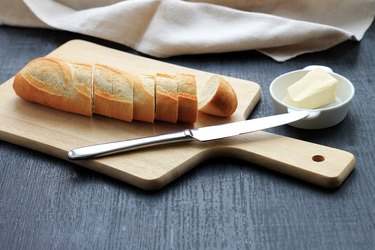
A fresh baguette is glorious when it's soft on the inside with a crusty exterior, but a hardened or stale baguette is unappetizing. The good news is that it's often possible to bring breads back to life when they're no longer fresh.
How to Soften Bread
Video of the Day
Penny Stankiewicz, Pastry & Baking Arts Chef-Instructor at the Institute of Culinary Education, tells LIVESTRONG.com how to revive baguettes and other breads. "To soften a baguette," she says, "run it under the faucet with warm water."
"Try not to let it soak through entirely, but give it a good coating. Place it in the oven, directly on the rack, at 350 degrees Fahrenheit for about 10 to 15 minutes, and it will come back."
Video of the Day
Read more: Nutritional Information of a French Baguette
According to Stankiewicz, you can refresh other types of bread in the oven that are a bit stale. "Set the temperature to 325 F. Spray the surface of the bread with a light coating of water and bake for about 10 minutes," she explains.
"If you don't have a spray bottle, dampen a kitchen towel and let it sit on the surface of the bread for about 15 minutes. Remove the towel and bake the bread in the oven for about 10 minutes."
Prevent and Revive Stale Bread
Another method for reviving stale bread involves the microwave. "Wet a paper towel and ring out all the extra water. Drape it over the bread and microwave in 20-second intervals until the bread is softened," Stankiewicz advises.
You can use the oven to restore the crusty exterior of bread, she notes. "Preheat the oven to 375 F, and place the bread on the rack. Bake for about 15 minutes or until the crust is set again."
Read more: How to Heat Bread in the Oven
Although you can revive stale bread, it always tastes best when it's fresh. Refrigeration can prevent mold from developing, but speeds the staling process, cautions North Dakota State University Extension. To preserve the fresh taste of bread, try to freeze whatever amount you don't plan to eat right away. If you put it in an air-tight bag, it should stay usable in the freezer for up to three months.
Despite your efforts at prevention, you may occasionally detect mold on bread. When this happens, throw it out to avoid the risks associated with ingesting mold.
Uses for Stale Bread
When bread goes stale, instead of reviving it, you might find other uses for it. For example, when combined with eggs, milk and other ingredients, it makes a delicious bread pudding, suggests the USDA's ChooseMyPlate.
Alternative dishes include French toast, garlic toast and grilled cheese sandwiches. Slightly stale bread also makes great toast that you can dress up in various ways. For example, try this LIVESTRONG.com recipe for sweet and savory Milk 'n' Honey Toast.
Another idea for stale bread is to toast it and make croutons or breadcrumbs, says North Dakota State University. To make croutons, cut the bread into cubes, and bake at 350 F until very dry. To make breadcrumbs, crush the bread with a rolling pin and add seasonings if desired.
Breadcrumbs from stale bread are perfect for cooking fritters, according to a June 2019 article published by the Folger Shakespeare Library. When combined with eggs, melted butter and seasonings and then fried in a skillet, they make a tasty dish.
Additional suggestions for breadcrumbs involve making making croquettes and use of them as a binder in meatloaf or meatballs. Many cooks also sprinkle them on casseroles to provide a crunchy topping.